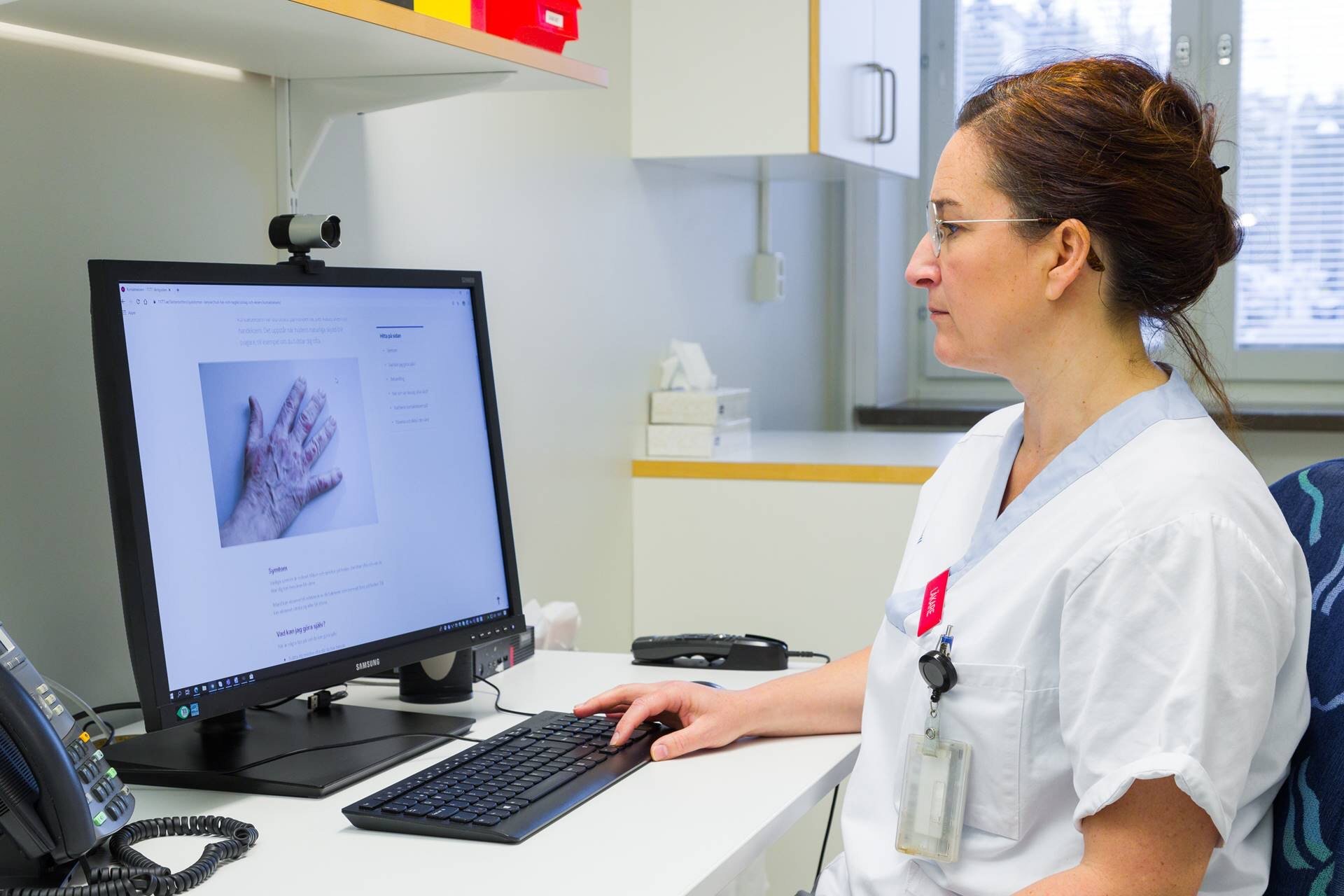For more than 270,000 inhabitants of the Västerbotten Region, a physical healthcare appointment often entails large costs in the form of time and long travel routes. But patients of the Dermatology and STI clinic in Umeå do not have to leave home – they can get in touch with healthcare staff digitally, via video or secure messaging.
The Dermatology and STI Clinic operates a general dermatology reception and a reception for sexually transmitted infections for the entire region. We spoke with Virginia Zazo Hernanz, dermatologist and formerly Head of Operations at the clinic, to hear more about why they were such early adopters in offering digital clinical pathways consultations and how they work with online consultations today.
From pilot to scaling up
The dermatology and STI clinic began testing different remote solutions for treating patients many years ago, Virginia says. The reasons were mainly to make specialists available to more patients and make healthcare easier for all the residents of the entire region, despite large geographical distances. Initially, it was available for staff of the health centres to connect to the specialists in real-time via a traditional telemedicine solution rather than direct patient contact.
For about 3 years, the clinic has been offering online consultations via Visiba Care’s platform. They realised early on the need to be able to rely on high-quality images to make good assessments, but wanted to find a solution that allowed the patients to skip visiting the clinic or a health centre, and instead could securely send pictures.
The solution for us was to use Visiba Care’s messaging function and the functions associated with video consultations, where images, documents, and files can be be shared securely.
Initially, the clinic worked with online consultations on a smaller scale and offered follow-up appointments after a physical visit to patients with acne problems – an initiative that gave good results and was appreciated by healthcare professionals and patients alike. As all parties were satisfied with the result, plans were made to scale up the business even before covid-19, but during the pandemic and the increased risk of infection, the transition to digital went faster than planned. Today, similar working methods are applied in the treatment of several other patient groups. Today it is mostly follow-up visits that are taking place digitally, and thanks to previous experience with Visiba Care, Virginia and her team were able to inspire and support others to get started in an optimal way.
During the pandemic, new routines have also been established. Usually, patients with more serious conditions are referred to the clinic via primary care, but during the pandemic, Virginia has received patients directly via the Visiba Care messaging service to relieve some pressure from the care centres and increase access to the patients.
 Virginia Zazo – Fotograf: Klas Sjöberg
Virginia Zazo – Fotograf: Klas Sjöberg
Opportunities for both patients and healthcare professionals
One evident advantage that Virginia sees in virtual appointments is the ability to share the screen with patients in a video meeting.
For people with skin problems, it is often important from a psychological point of view to see progress during treatment. By sharing the screen and displaying pictures taken during treatment, the patient can see the change himself/herself. Being able to do this from the safety of their home environment is a great advantage.
Virginia sees no direct disadvantages with virtual appointments, but rather believes that the right channel should be used for the right stage in the treatment process. She also believes that it is important for doctors who make a diagnosis based on photographs to have some experience – they need to have gone through many pictures to make a safe assessment.
I am generally very positive about online consultations. We can increase accessibility and we have the opportunity to see patients in their home environment, which creates additional value as you gain a better understanding of the context the patient lives in – which can be important for the treatment. There is an ongoing discussion currently about quality, patient-centric care now, and this is patient-centric care in a nutshell.
Reaching more patients with messaging
As the covid-19 pandemic spread across Europe, Virginia followed the developments closely, especially what was happening in her country of origin, Spain. She saw how doctors there were using just messaging services to communicate with patients in isolation and in their homes and she wondered how she could use the messaging service in Visiba Care to continue treatments and relieve pressure from the Health Centres.
The main advantage of messages is that it is asynchronous. I can staff it when I have time and I can open and close the message channel as needed. Patients can submit their case around the clock, they can freely describe their problems and attach pictures. If they send the message before 5PM, they receive a reply within 48 hours. Most cases can be managed directly via messaging. In some cases I have booked a video consultation – especially if I need more background information – and in a few cases, I have asked them to wait or come in to the physical reception.
In addition, the messaging function seems to make the clinic more accessible to patients who might otherwise not reach out to healthcare for their conditions.
One person wrote that they avoided seeking help earlier because they did not want to physically show up. Through messaging, I was able to persuade the person to send in a picture; I was able to make a diagnosis and provide them with the right treatment. Another person had been having trouble for months without seeking treatment, probably because it is often not that simple. You need to go through primary care to get a referral and only then can you get a time with us.
Making time for the ones who need it the most
Some believe that human contact may be impaired in online consultations, but Virginia does not share this view. On the contrary, she believes that the virtual consultation is more focused, as there will be fewer interruptions in the conversation. But of course, there are times when patients need to come in to the physical reception. It is therefore important to be able to offer different alternatives.
I see online consultations as a chance to make more time for those who really need it. It saves a lot of time compared to physical visits – you do not have to travel, set aside time, take time to undress and dress and other things. The patients are ready when they meet me digitally. By saving time this way, we can spend more time on the patients who really need to meet us physically, which is fantastic.
Simple to use Visiba Care
Virginia thinks that it is simple and easy to work in Visiba Care’s platform. The patients also think it works well and they have no problems understanding how to use the various functions. This applies to all ages.
Sometimes I have had to show the patient how to, for example, upload pictures, but then I use the screen sharing function to show how to do it and it works very well.
Even during the video consultation, Virginia is happy to use the messaging feature, for example, to share tips and advice or to provide information on how to take care of a particular skin condition.
When I physically meet my patients, I usually sketch a lot to help them understand. In the video consultation, the messaging function performs the same function.
Virginia also believes it is valuable to have access to statistics and to follow-up with data, and sees great opportunities in developing the reporting function get even more data that can be used to improve the service delivery. In addition, she sees benefits in an even more seamless user experience, where different healthcare systems are integrated with each other.
6 tips from Virginia for healthcare professionals who want to get started
- Become familiar with the technology! When you are confident in the tool, it becomes much easier
- Test with a colleague, and go through various functions.
- Remember to behave just like you usually do.
- Wear your usual medical clothes.
- Consider what your background looks like – avoid a messy background that can be distracting.
- Just try it! It gives so much value and it’s easy – in addition, you make more time for something else.


